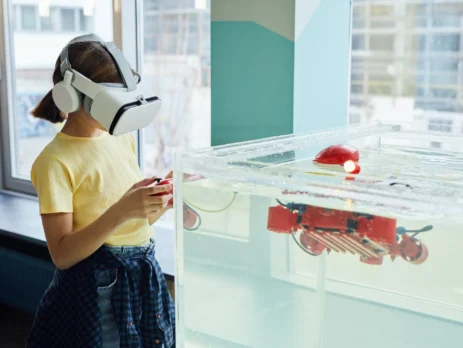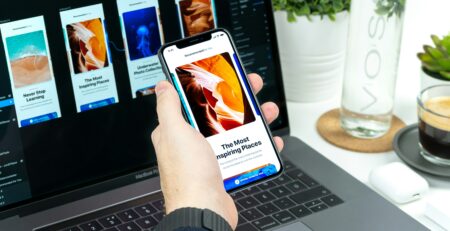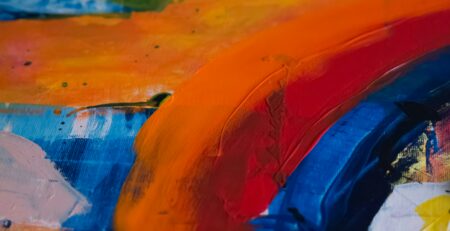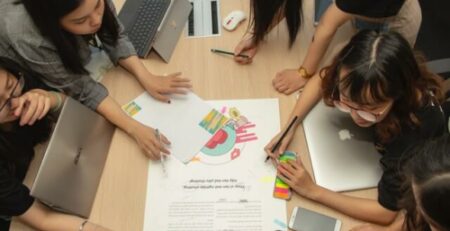Rediscovering the Joy of UI & UX Design in 2024
It’s no secret that the world of UI/UX design is constantly evolving at a rapid pace as new technologies emerge and user behaviors change. If you’re a designer with years of experience, it can be easy to fall into routines that weaken your initial passion for this creative field. To remain excited about this meaningful work, you must make intentional efforts to rediscover the joy of the craft. So, in this informative read, we hope to offer some perspective and realistic ideas to help you rekindle that innovative spirit within yourself, whether you’re a seasoned pro or just starting out.
How UI/UX Design Has Evolved In 2024
UI/UX design continues to evolve rapidly to meet new technological and user challenges. As such, you must adapt to keep up with these advancements to stay ahead of the game and keep that initial spark that drew you to the field alive. Here are some major ways UI/UX design evolved to keep up with rapid technological changes and growing user and business requirements through 2024:
Increased Focus on Personalization
Personalization has become such a big focus for designers in recent years. With all the advances in collecting and analyzing user data, companies are getting much better at understanding individual people and their specific needs or preferences. Designers are taking all these insights into how people behave online and using them to give everyone a more customized experience.
It’s also possible now to remember different choices people make about layouts, fonts, colors, and so on, then apply those personalized settings anytime they return. The goal is to deliver the most relevant content tailored to each individual. Naturally, privacy and security stay hugely important, too. So, these techniques are designed and tested carefully to balance customized features versus potential overreach or not giving users full control over their data.
3D UX Designs
As technology has advanced, users now have access to immersive 3D experiences through virtual and augmented reality headsets. This has driven UI/UX design to evolve beyond the traditional 2D interface on phones and computers. Designers now think in three dimensions to create truly compelling and intuitive user experiences.
3D UX design enables interactions that simply weren’t possible before. No longer confined to flat screens, designers can place digital objects and interfaces anywhere in 3D space. The sense of depth, scale, and spatial awareness that 3D provides completely transforms how users engage with an experience.
Dark Mode
Although it started as a niche preference a few years ago, dark mode is now a standard feature consumers expect apps and websites to support. Its popularity reveals how our relationship with digital interfaces has changed.
Initially, dark mode was mainly about reducing eye strain in dim lighting. But as our screens got brighter and brighter and the tasks we do on them got more visually intensive, it became clear that dark backgrounds with light text are just easier on the eyes when you’re looking at them for long periods. This has been a huge driver in its adoption. It shows that flexibility and prioritizing user comfort should come before strictly adhering to past design conventions.
Augmented Reality (AR) And Virtual Reality (VR) Designs

AR and VR have started to come into their own these last few years. The crazy improvements in processing power and sensors have opened many doors for designers to get creative with how people interact in those virtual environments. Designers are now beginning to think about how virtual content can enhance rather than replace real experiences.
Much focus has been on perfecting UI conventions in these spatial, multidimensional virtual spaces. Things like menus that transition smoothly between flat screens and 3D depending on gestures – it all feels so much more seamless now. It is also great that functions can be grouped and accessed intuitively directly through 3D manipulation in VR
Why Is It Important to Rediscover the Joy of UI and UX Design?
Boosts Creativity and Innovation
Rediscovering that sense of joy in your work does wonders for your creativity and ability to innovate. When you’re having fun with what you’re doing, it just opens you up so much more.
There’s something about being in a positive, playful mindset that gets those creative juices flowing way more than being discouraged or burned out. You’re more willing to experiment with crazy ideas without the fear of failure weighing you down. And that’s important for pushing design forward instead of sticking to what’s safe. Even small acts of rediscovering fun through daily challenges or learning something new give your perspective a refreshing boost.
Enhances User Experience
There’s a noticeable difference between something created out of passion versus feeling like a chore. If you enjoy the process, you’ll be much more eager to put yourself in the user’s shoes at every step. It helps you identify those subtle pain points or new opportunities for delight that others might gloss over. And this is reflected in the user experience.
You can also tell when someone took the time to infuse heart into all the small details. Things like thoughtful micro-interactions, hidden Easter eggs, or surprising animations for no other reason than to bring a smile. That level of craft doesn’t happen without a strong sense of joy driving it.
Improves Mental Health and Reduces Burnout

Alt-Text: A tired man at the office.
UI/UX design can drain you if you’re not careful. When you’re always feeling overwhelmed or frustrated, it just wears on you so much over time. But even small acts of rediscovering fun at work do wonders for breaking up that stress and anxiety. Suddenly, the burden doesn’t feel so heavy.
Approaching problems creatively instead of critically is also a lot less taxing mentally. It’s not about being harder on yourself for mistakes but celebrating small wins. That positive mindset is so restorative when the job gets rough.
Refreshes Designers’ Motivation and Careers
It’s easy to lose the initial passion for your work in this field if you’re not mindful. When you’re having fun, it’s way easier to stay invested even through periods of monotony or feeling stagnant in your growth. But without that sense of enthusiasm, it’s a slippery slope towards apathy or dissatisfaction creeping in.
Joy breathes new energy into your career goals as a designer and willingness to tackle bigger challenges. Learning for the pure fun of learning rather than obligation drives people to constantly take their skills further
Strengthens Understanding of Best Practices
When designers enjoy what they do, they cement good processes and techniques into how they approach problems. There’s a playfulness to learning that sticks with you better than grinding it out. If you’re having fun experimenting with new methods, you’re more engaged with evaluating what works, what doesn’t, and why. You pay closer attention to those subtle results that provide real insight rather than checked boxes.
It’s also easier to appreciate lessons from failures when you see them as part of an exciting discovery process, not personal shortcomings. That lets you internalize each experience for future improvement.
6 Ways To Rediscover the Joy of UI/UX Design In 2024
For those in UX design specifically, feeling joy and intrigue in your work is crucial for cultivating innovative, empathetic solutions that genuinely improve people’s lives. Now more than ever, amidst rapid changes to how we interact digitally, rediscovering your joy in the field is crucial for growth. Some approaches to consider include:
- Rediscover the User’s Perspective

One of the best things designers can do is refocus on truly understanding who they’re creating for. Sometimes, when you’re buried in specs and code for too long, it’s easy to lose sight of the human on the other side of the screen. But reconnecting with users is so key for rediscovering why this work matters.
Getting out of the office and observing real people achieve tasks, struggle with pain points, and experience your existing designs with fresh eyes is illuminating in a whole new way. Things you’d never think of on your own, leap out. And that fires you up to want to solve real problems, not just check boxes.
Suddenly, your work feels purposeful again in a meaningful way. That joy carries right on through to your creative process.
- Reconnect with Design Principles and Basics
When you start to feel burnt out or uninspired, taking a step back to refamiliarize yourself with some of the core principles of design is always so refreshing at times like that. Things like accessibility and responsive design, the fundamentals, can inject that “a-ha!” feeling. Sitting down and doing a little refresher on what makes experiences truly intuitive and inclusive can spark new ideas.
It’s easy to get tunnel vision when you’re pushing boundaries on every project. But reconnecting with the basics can really help you step outside the minor details and refocus on serving the user first before anything else. Just slowing down to nourish your knowledge of principles ends up reminding you why you fell in love with this field, to begin with.
- Embrace Setbacks as a Source of Innovation
It’s easy to get down on yourself in this job when things don’t go according to plan. Nobody likes making mistakes, so it’s easy for any kind of setback or limitation to feel like a failure. So many designers see challenges as problems to avoid, but the most innovative think outside the box.
Setbacks are inevitable in any creative field. Clients change requirements, tech hitches emerge, and research can contradict your ideas. But it’s all part of the process. Rather than fight it or fret, see it as fuel. Limitations spark new solutions, after all.
The UI and UX design field solves problems creatively. And with practice, any perceived limitation has the potential to spark fresh insights. Let 2024 be the year you stop defining yourself by what doesn’t work. See failure as a chance to grow, as all innovators do.
- Prioritize Collaboration and Discovery
So much of designing depends on interacting with others – from gathering requirements to testing designs. In 2024, prioritize making connections with colleagues and uncovering insights together. Schedule catch-ups just to share what you’re learning from projects, not to coordinate tasks. Learn from each other’s challenges and triumphs.
You’d be surprised how fueling relationships re-inspires passion. Bouncing ideas off peers stimulates creativity and prevents isolation. Even small water cooler chats may spark whole new problem spaces to explore. Discovery goes both ways – don’t forget to listen to others too genuinely. Make time to understand staff, clients, and customers beyond surface transactions.
- Play and Experiment
In this business, it’s too easy to get consumed by best practices, constraints, and critical client deadlines. But some of the most innovative work happens when you loosen up and try new things just for the fun of it. Making time to simply play and experiment could be what helps you fall back in love with UX design next year. You can carve out small periods each week for low-stakes tinkering without the stress of everything fitting a certain process or standard.
Play also helps you step outside stale patterns by reducing the fear of failure. With zero expectations, you can freely twist conventions and try unorthodox flows, inputs, or presentations. Some wild ideas will flop, but they can yield insights to refine your work.
- Rediscover Your Sense of Purpose and Impact
You can easily lose sight of why you do what you do amid daily tasks and targets. But reconnecting with your ‘why’ may be pivotal to rediscovering wonder in your work in 2024.
Take time to reflect on your core motivations for entering this field originally. Was it to solve meaningful problems? Improve people’s lives through design? Visualize – how have your past projects created positive change, however small? Internalizing these impacts can give you a fresh perspective.
You could also revisit your long-term goals and evaluate if your day-to-day aligns. Are you growing the skills needed to reach your vision? If not, craft an intentional development plan linking your efforts to your aspirations.
Reignite Your Spark
At the end of the day, UI and UX design provides so much creative satisfaction through solving problems and improving lives, even if daily tasks can make that joy fade temporarily. The hustle of projects and timelines in your design journey may cause stress, but you must remember why you fell in love with this career to help reignite that sense of wonder and fulfillment. Making small adjustments to your mindset and process can also help reignite your passion.
icreatives can help UI/UX designers and companies alike rediscover the joy of design in the new year. For designers wanting to experiment outside their normal work, we can connect you to various short-term freelance projects across many industries. Companies also gain by leveraging our talent pool for design needs beyond what their in-house team can handle. Call us at (+1) 855-427-3284 for more inquiries.












